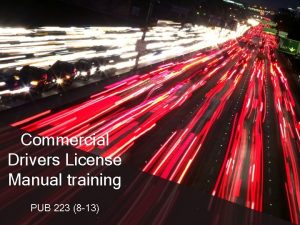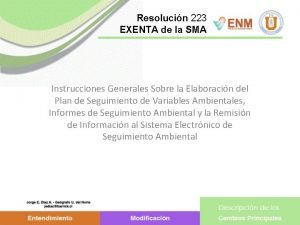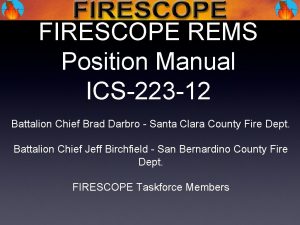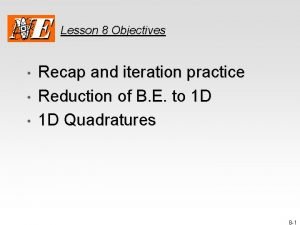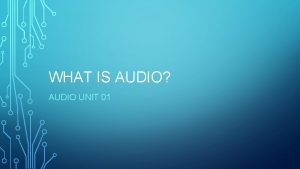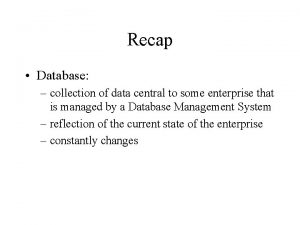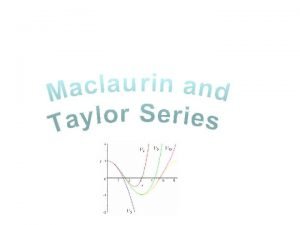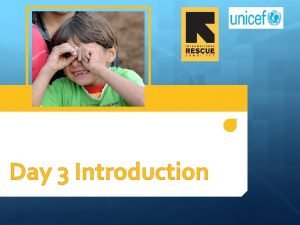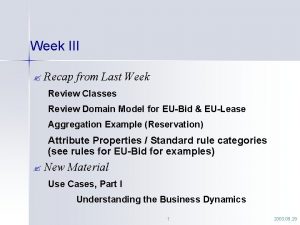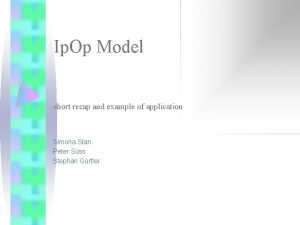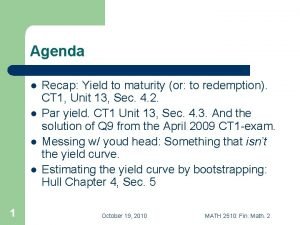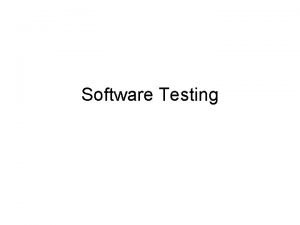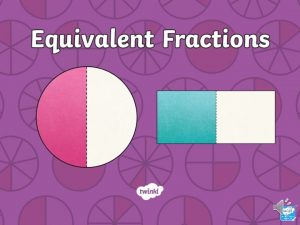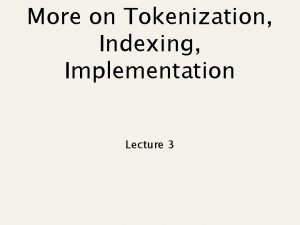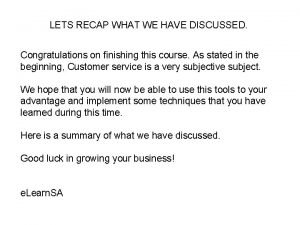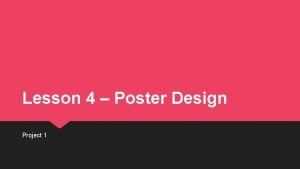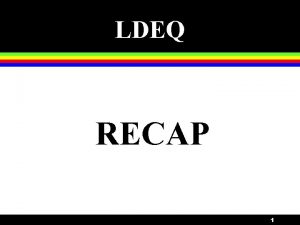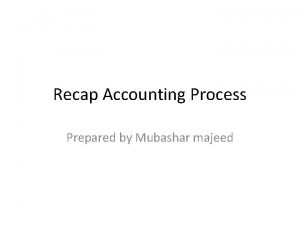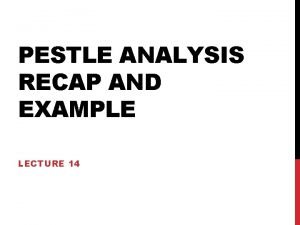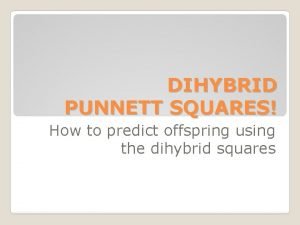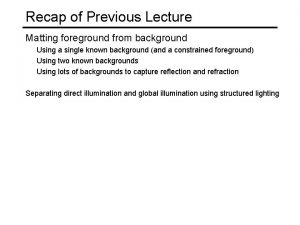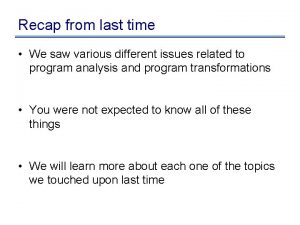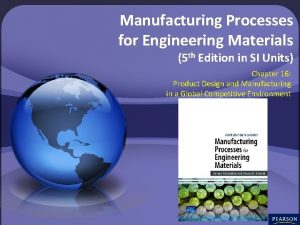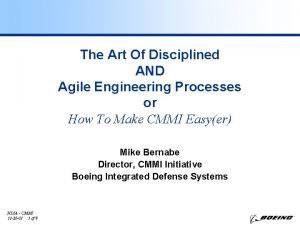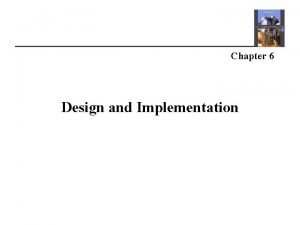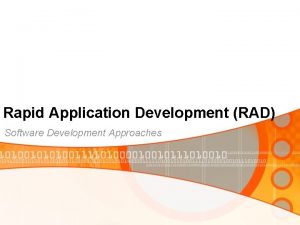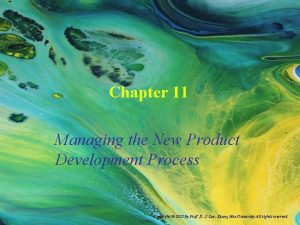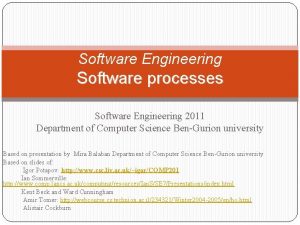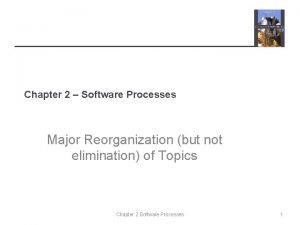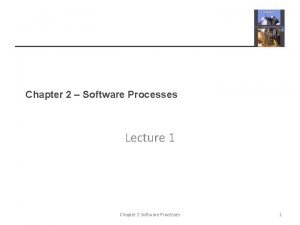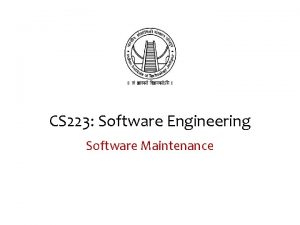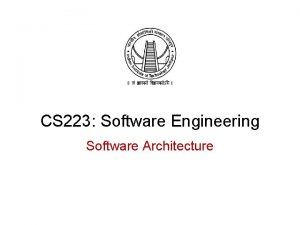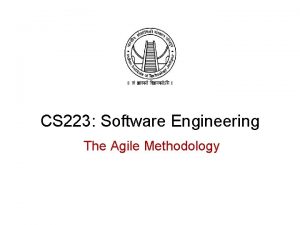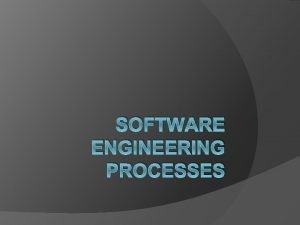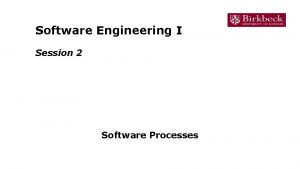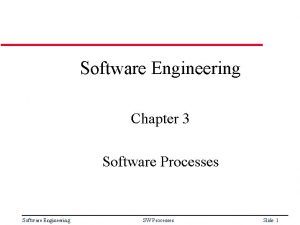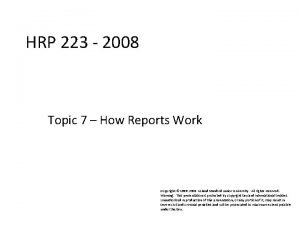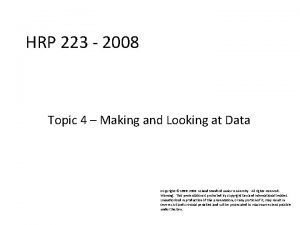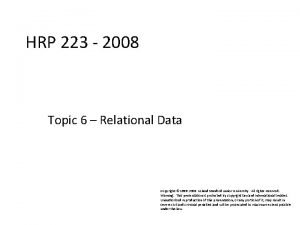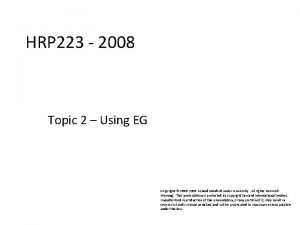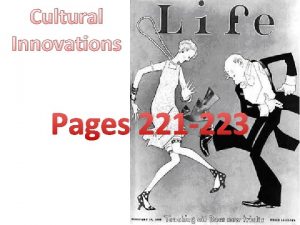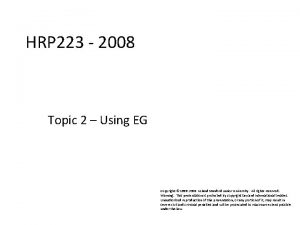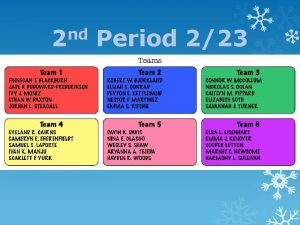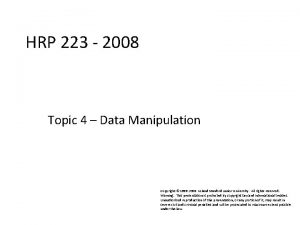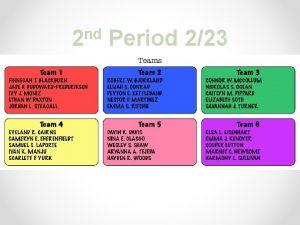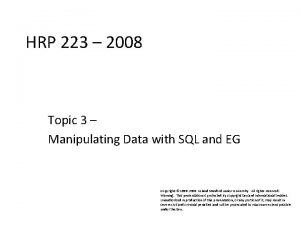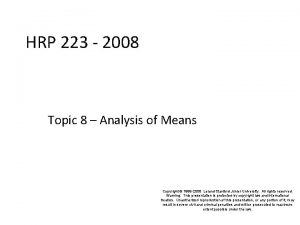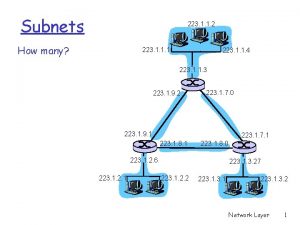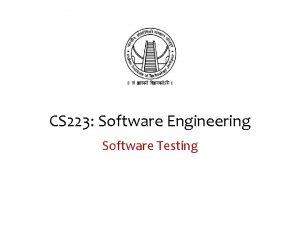CS 223 Software Engineering Software Development Processes Recap

























































- Slides: 57

CS 223: Software Engineering Software Development Processes

Recap • Software engineering as a bridge between customer and developer • Different misconceptions about software developments • Legacy software • Software developments phases

Objective • After the end of the class students should be able to o State professional responsibilities of a software engineer o Explain the need of software processes o Describe ETVX model o Differentiate between different properties of software processes


What is a software process? • A set of ordered tasks to produce indented output of some kind o Involving activates, o Constraints; and o Resources • The process of building a software product o Life cycle Ø Describes the life of the software from conception through § implementation, § delivery, § use and § maintenance.

Component Software Processes • Two major processes o Development Ø focuses on development and quality steps needed to engineer the software o Project management Ø focuses on planning and controlling the development process • Development process is the heart of software process; other processes revolve around it • These are executed by different people o Developers execute engineering process o Project manager executes the management processes

Component Processes… • Other processes o Configuration management process Ø manages the evolution of artifacts o Change management process Ø how changes are incorporated o Process management process Ø management of processes themselves o Inspection process Ø How inspections are conducted on artifacts

Process Specification • Process is generally a set of phases • Each phase performs a well defined task and produces an output • Intermediate outputs – work products • At top level, typically few phases in a process • How to perform a particular phase o Methodologies have been proposed

ETVX Specification • ETVX approach to specify a step o Entry criteria: conditions to be satisfied for initiating this phase o Task: what is to be done in this phase o Verification: the checks done on the outputs of this phase o e. Xit criteria: when can this phase be considered done successfully • A phase also produces info for management

ETVX approach A B C D

Desired Process Properties • Provide high quality and productivity (Q & P) • Support testability as testing is the most expensive task o Testing can consume 30 to 50% of total development effort • Support maintainability o Maintenance can be more expensive than development; o Over life up to 80% of total cost • Remove defects early o As cost of removing defects increases with latency

High Q&P: Early Defect Removal… • Cost of a defect increases with latency • Fixing a defect in operation can cost a 100 times the cost of fixing it in requirements itself • For high Q&P, the process must support early defect removal • That is why there is a V in ETVX, and quality control tasks in the software process

Early Defect Removal…

Desired Properties… • Predictability and repeatability o Process should repeat its performance when used on different projects Ø Outcome of using a process should be predictable o Past performance can be used to predict future performance o Without predictability, cannot estimate, or say anything about quality or productivity

Predictability… • Predictable process is said to be under statistical control o Repeatedly using the process produces similar results o Results – properties of interest like quality, productivity, … • To consistently develop software with high Q&P o Process must be in control

Predictability… Expected value of the property Allowable error bound

Support Change • Software changes for various reasons • Requirements change is a key reason • Requirement changes cannot be wished away or treated as “bad” • They must be accommodated in the process for software development

Software Project • Project o To build a software system within cost o Schedule and with high quality which satisfies the customer • Project goals – high Q and high P • Suitable process needed to reach goals • For a project o The process to be followed is specified during planning

Projects Process • If a project chooses a model o It will generally tailor it to suit the project • This produces the spec for the projects process • This process can then be followed in the project • Process is what is actually executed • Process specification is plan about what should be executed • Process model is a generic process specification • Many models have been proposed for the development process

Development Process • A set of phases and each phase being a sequence of steps • Sequence of steps for a phase - methodologies for that phase. • Why have phases o To employ divide and conquer o Each phase handles a different part of the problem o Helps in continuous validation

Development Process • Commonly has these activities: o Requirements analysis, architecture, o Design, coding, o Testing, delivery • Different models perform them in different manner

Generic software process models • The waterfall model o Separate and distinct phases of specification and development. • Evolutionary development o Specification, development and validation are interleaved. • Component-based software engineering o The system is assembled from existing components.

Waterfall Model • Linear sequence of stages/ phases • Requirements – HLD – DD – Code – Test – Deploy • A phase starts only when the previous has completed o No feedback • The phases partition the project o Each addressing a separate concern

Flow of Waterfall Model

Properties of Waterfall Model • Linear ordering implies each phase should have some output • The output must be validated/certified • Outputs of earlier phases: work products • Common outputs of a waterfall: o SRS, project plan, design docs, test plan and reports, final code, supporting docs

Waterfall Advantages • Conceptually simple o Cleanly divides the problem into distinct phases o Phases can be performed independently • Natural approach for problem solving • Easy to administer in a contractual setup • Each phase is a milestone

Waterfall disadvantages • Assumes that requirements can be specified and frozen early • May fix hardware and other technologies too early • Follows the “big bang” approach o All or nothing delivery o Too risky • Requirement bloating • Very document oriented o Requiring docs at the end of each phase

Waterfall Usage • Has been used widely • Well suited for projects where o Requirements can be understood easily o Technology decisions are easy • For familiar type of projects it still may be the most optimum

Prototyping • It addresses the requirement specification limitation of waterfall • Do not finalize requirements only by discussions • A prototype is built to understand the requirements • Helps reduce the requirements risk • A small waterfall model replaces the requirements stage

Prototyping: Typical flow

Developing A Prototype • Starts with initial requirements • Only key features which need better understanding are included in prototype • No point in including those features that are well understood • Feedback from users taken to improve the understanding of the requirements

How to minimize the cost? • Build only features needing clarification • “Quick and dirty” o Quality not important, scripting etc. can be used • Things like exception handling, recovery, standards are omitted • Cost can be a few % of the total • Learning in prototype building will help in o Building the software o Besides improved requirements

Pros and Cons of Prototyping • Advantages: o Requirement will be more stable o Requirement frozen later o Experience helps in the main development • Disadvantages: o Potential hit on cost and schedule • Applicability: o When requirements are hard to elicit o Confidence in requirements is low Ø Requirements are not well understood

Iterative Development • Counters the “all or nothing” drawback of the waterfall model • Combines benefit of prototyping and waterfall • Develop and deliver software in increments • Each increment is complete in itself • Can be viewed as a sequence of waterfalls • Feedback from one iteration is used in the future iterations

Typical Flow of Iterative Enhancement

Iterative delivery approach

Properties of Iterative Development • Products almost always follow it • Used commonly in customized development also o Businesses want quick response for software o Cannot afford the risk of all-or-nothing • Newer approaches like XP, Agile, … all rely on iterative development

Pros and Cons of Iterative Development • Benefits: o Get-as-you-pay o Feedback for improvement, • Drawbacks: o Architecture/ design may not be optimal, o Rework may increase, total cost may be more • Applicability: o Response time is important, risk of long projects cannot be taken, o All requirements are not known

Timeboxing • Iterative is linear sequence of iterations • Each iteration is a mini waterfall o Decide the specs, then plan the iteration • Time boxing o Fix an iteration duration, then determine the specs • Divide iteration in a few equal stages • Use pipelining concepts to execute iterations in parallel

Time Boxed Iterations • General iterative development I. Fix the functionality for each iteration, II. Then plan and execute it • In time boxed iterations I. Fix the duration of iteration II. Adjust the functionality to fit it • Completion time is fixed o The functionality to be delivered is flexible

Characteristics of Time boxed Iteration • This itself very useful in many situations • Has predictable delivery times • Overall product release and marketing can be better planned • Makes time a non-negotiable parameter and helps focus attention on schedule • Prevents requirements bloating • Overall development time is still unchanged

Timeboxing – Taking Time Boxed Iterations Further • What if we have multiple iterations executing in parallel • Can reduce the average completion time by exploiting parallelism • For parallel execution, o Can borrow pipelining concepts from hardware • This leads to Timeboxing Process Model

Timeboxing Model – Basics • Development is done iteratively in fixed duration time boxes • Each time box divided in fixed stages • Each stage performs a clearly defined task that can be done independently • Each stage approximately equal in duration • There is a dedicated team for each stage • When one stage team finishes, it hands over the project to the next team

Properties of Timeboxing • With this type of time boxes, o Can use pipelining to reduce cycle time • Like hardware pipelining o View each iteration as an instruction • As stages have dedicated teams • Simultaneous execution of different iterations is possible

Example • An iteration with three stages – Analysis, Build, Deploy o These stages are approximately equal in many situations o Can adjust durations by determining the boundaries suitably o Can adjust duration by adjusting the team size for each stage • Have separate teams for A, B, and D

Pipelined Execution • AT starts executing it-1 • AT finishes, hands over it-1 to BT, starts executing it-2 • AT finishes it-2, hands over to BT; BT finishes it-1, hands over to DT; AT starts it-3, BT starts it-2 (and DT, it-1)

Timeboxing Execution

Timeboxing execution • First iteration finishes at time T • Second finishes at T+T/3; third at T+2 T/3, and so on • In steady state, delivery every T/3 time • If T is 3 weeks, first delivery after 3 weeks, 2 nd after 4 weeks, 3 rd after 5 weeks, … • In linear execution, delivery times will be 3 weeks, 6 weeks, 9 weeks, …

Timeboxing execution • Duration of each iteration still the same • Total work done in a time box is also the same • Productivity of a time box is same • Yet, average cycle time or delivery time has reduced to a third

Team Size • In linear execution of iterations, the same team performs all stages • If each stage has a team of S, in linear execution the team size is S • In pipelined execution, the team size is three times (one for each stage) • The total team size in timeboxing is larger; and this reduces cycle time

Tasks of different teams

Timeboxing • Advantages: o Shortened delivery times, o Other advantages of iterative, distributed execution • Disadvantages: o Larger teams, o Project management is harder, o High synchronization needed, CM is harder • Applicability: o When short delivery times very important o Architecture is stable o Flexibility in feature grouping

Summary – Waterfall Strength • • Simple Easy to execute Intuitive and logical Easy contractually Weakness • • • All or nothing – too risky Requirements are frozen early May chose outdated hardware/tech Disallows changes No feedback from users Encourages req bloating Types of Projects • • • Well understood problems, Short duration projects, Automation of existing manual systems

Summary – Prototyping Strength • • • Helps requirement elicitation Reduces risk Better and more stable final system Weakness • • Front heavy Possibly higher cost and schedule Encourages requirement bloating Disallows later change Types of Projects • • • Systems with novice users Areas with requirement uncertainty. Heavy reporting based systems can benefit from UI proto

Summary – Iterative Strength • • Regular deliveries, leading to biz benefit Can accommodate changes naturally Allows user feedback Avoids requirement bloating Naturally prioritizes requirement Allows reasonable exit points Reduces risks Weakness • • Overhead of planning each iteration Total cost may increase System arch and design may suffer Rework may increase Types of Projects For businesses where time is imp; risk of long projects cannot be taken; req not known and evolve with time

Summary – Timeboxing Strength Weakness Types of Projects All benefits of iterative Planning for iterations somewhat easier Very short delivery times PM becomes more complex Team size is larger Complicated – lapses can lead to losses Where very short delivery times are very important Where flexibility in grouping features Arch is stable

Thank you Next : Requirement Engineering
 Dl 11cd
Dl 11cd Res 223 sma
Res 223 sma Hqda exord 223-17
Hqda exord 223-17 Firescope rems
Firescope rems Concurrent in os
Concurrent in os What is system design in software engineering
What is system design in software engineering Forward engineering in software engineering
Forward engineering in software engineering Shawshank redemption film study
Shawshank redemption film study Chapter 8 of great gatsby summary
Chapter 8 of great gatsby summary What is price matching
What is price matching What is the purpose of an iteration recap
What is the purpose of an iteration recap Recap intensity clipping
Recap intensity clipping 60 minutes recap
60 minutes recap Recap database
Recap database Differentiation recap
Differentiation recap Introduction for recap
Introduction for recap Recap introduction
Recap introduction Recap from last week
Recap from last week Questions for act one of the crucible
Questions for act one of the crucible Ezekiel cheever motivation
Ezekiel cheever motivation Logbook recap example
Logbook recap example Ytm recap
Ytm recap Black box recap
Black box recap Fractions recap
Fractions recap Recap
Recap X-axis
X-axis Recap indexing scans
Recap indexing scans Lets have a recap
Lets have a recap Recap poster
Recap poster Public transportation essay
Public transportation essay Ldeq recap
Ldeq recap Romeo and juliet act 1 summary
Romeo and juliet act 1 summary Recap accounting
Recap accounting Example of recap
Example of recap Let's recap
Let's recap Let's recap
Let's recap Foil method biology
Foil method biology Recap background
Recap background Normative ethics
Normative ethics Saw recap
Saw recap Briefly recap
Briefly recap Manufacturing process for engineering materials
Manufacturing process for engineering materials Agile engineering processes
Agile engineering processes Implementation in software engineering
Implementation in software engineering Rad software engineering
Rad software engineering Parallel development processes are universally endorsed.
Parallel development processes are universally endorsed. Software maintenance process models ppt
Software maintenance process models ppt Who invented software engineering
Who invented software engineering Metrics computer science
Metrics computer science Software crisis in software engineering
Software crisis in software engineering Software measurement and metrics in software engineering
Software measurement and metrics in software engineering Real time software design in software engineering
Real time software design in software engineering Software design fundamentals in software engineering
Software design fundamentals in software engineering Software requirement and design
Software requirement and design Software processes
Software processes Software processes
Software processes Engineering elegant systems: theory of systems engineering
Engineering elegant systems: theory of systems engineering Elegant systems
Elegant systems
